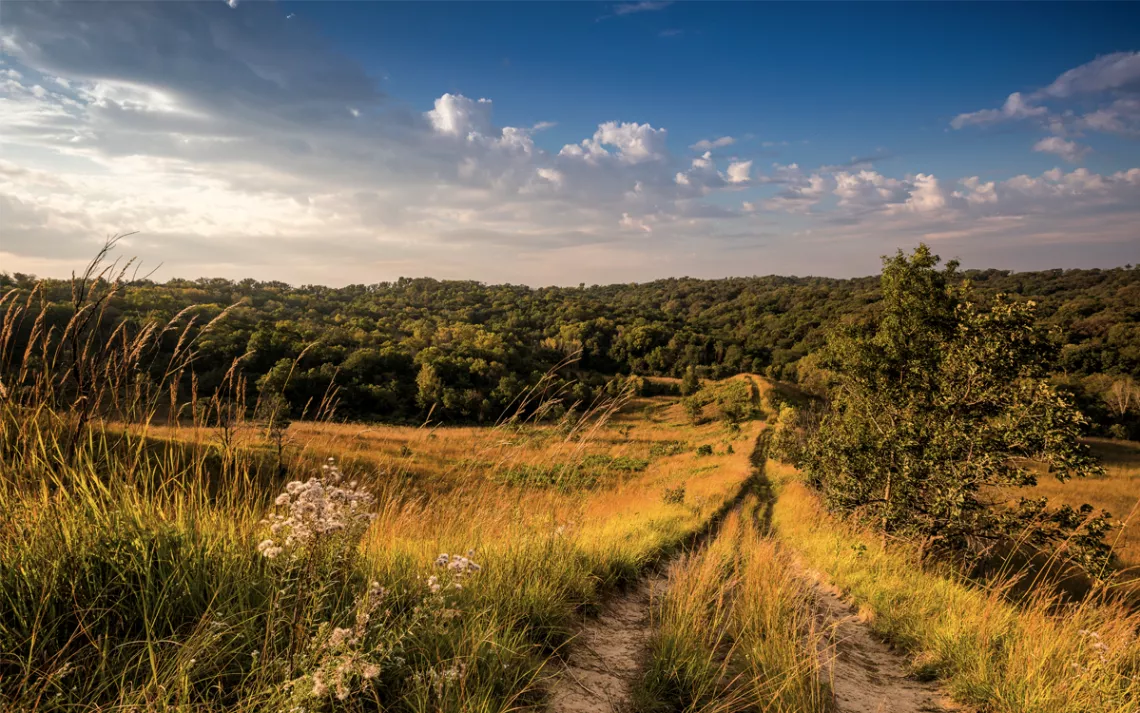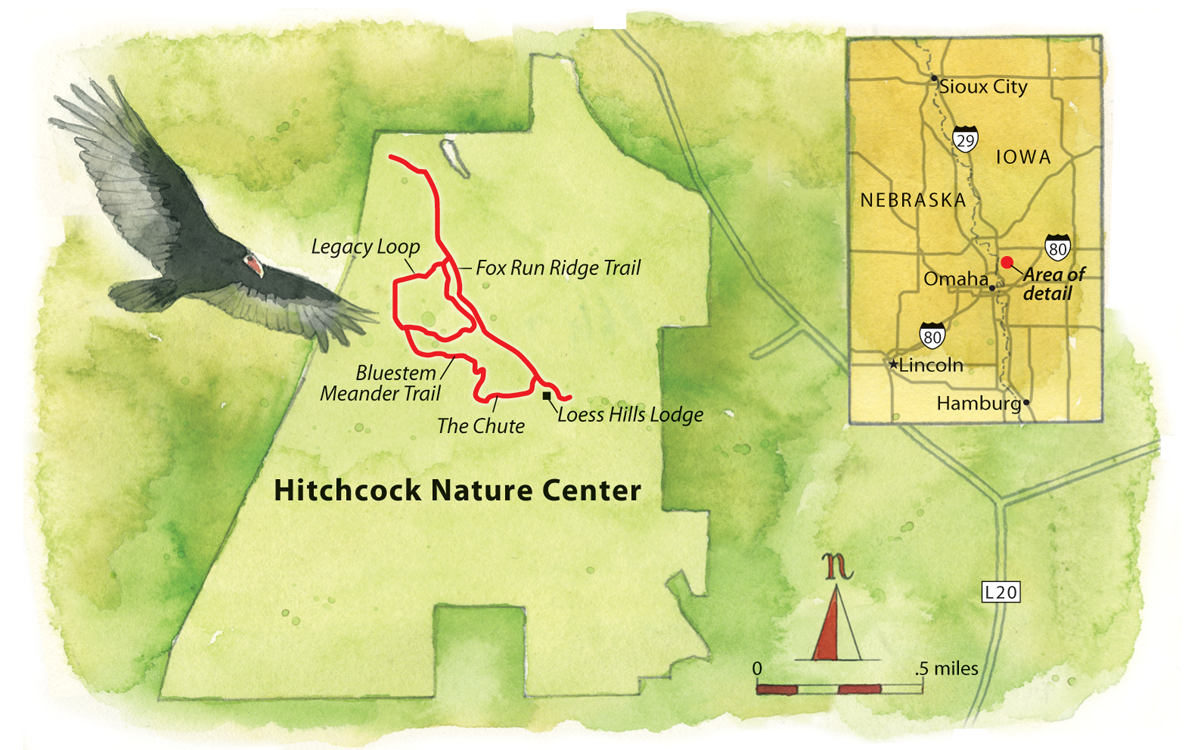Surprise Thrills on Iowa's Most Intense Trail
A writer goes on a grand adventure at home after postponing a Grand Canyon trek

Western Iowa's Loess Hills are a landscape of prairie, steep bluffs, and narrow ridges that formed at the end of the most recent ice age. | Photo by Justin Rogers
In the parking lot, I may have appeared a tad overprepared, gripping a titanium trekking pole in each hand and clenching the hose of my hydration pack between my teeth. But I was ready—ready to conquer one of the most difficult trails in all of Iowa.
This was not the trail I'd thought I would be hiking. For the past year, I'd been preparing for a three-day backpacking trip in the Grand Canyon with a regimen of squats, lunges, and kettlebell swings, even succumbing to the tedium of the StairMaster. Then, on a September morning after a heavy rain, I walked out my back door to take out the trash, slipped, and hyperextended my left knee. This was the same knee that had sidelined me for years after a freak injury at 52. I had planned to hike the Grand Canyon to celebrate its recovery.
It's hard to train for a big hike, knee injury or no, in Iowa. In the 12 years I've lived here, I've grown to love the pastoral charm of its gentle rolling hills (think Grant Wood paintings)—but Iowa is still the Midwest, not the West. I grew up cradled by mountains in Arizona, then lived in the rugged Cascade Range in Washington. Iowa is home to more cornfields than native prairies, more hogs than humans, and, true to its reputation as a flyover state, more contrails than hiking trails.
The aborted Grand Canyon plan left me disappointed but also determined to get back on the trail. Any trail. I went to the AllTrails website and found the Hitchcock Nature Center Loop, which, at 6.3 miles and with a significant elevation gain, is rated "hard." About four hours west of my home in Iowa City, the trail is situated in a 1,268-acre prairie preserve in the Loess Hills.
During the most recent ice age, glaciers melted north of Iowa, sending enormous quantities of water and sediment rushing down the Missouri River valley, where the deluge eventually took the form of huge mudflats. Strong westerly winds picked up the silt and redeposited it, layer upon layer. This process repeated for thousands of years, creating the Loess (a German word meaning "windblown sediment") Hills. Some rise 200 feet—tall for Iowa—above the floodplain.
 Map by Steve Stankiewicz As my car neared the preserve that October Saturday, I spied the distinctive peaks and saddles of the Loess Hills. On my right, acres of slate-blue water rippled in the breeze like a mirage, reflecting the clear sky above. I momentarily forgot I was in a landlocked state. The standing water, where farmland should be, was the wet remnant of the previous spring's floods, which had displaced thousands of residents in communities along the Missouri River. More than 40 levees had been breached, and the fields were still saturated six months later.
Map by Steve Stankiewicz As my car neared the preserve that October Saturday, I spied the distinctive peaks and saddles of the Loess Hills. On my right, acres of slate-blue water rippled in the breeze like a mirage, reflecting the clear sky above. I momentarily forgot I was in a landlocked state. The standing water, where farmland should be, was the wet remnant of the previous spring's floods, which had displaced thousands of residents in communities along the Missouri River. More than 40 levees had been breached, and the fields were still saturated six months later.
From the deck of the Hitchcock Nature Center's lodge, I could see the Fox Run Ridge Trail running atop the most prominent ridge and decided to start there. After half a mile, I turned down Legacy Loop, one of the red sections the map designated "most difficult," and froze. Before me spilled a decline so impossibly steep, I wanted to turn tail and go back to the lodge. There were no switchbacks, no steps formed from rocks or logs, just straight-down terrain. I stood for a minute, wondering how anybody made it down this trail.
I side-slipped my way down, planting a pole ahead of each baby step, my hamstrings straining under the tension. After about 50 yards, the trail leveled out, mercifully, but then down it went again. I came to a campsite and rested for a while, imagining what it would be like to spend the night. Maybe it was best I hadn't made the Grand Canyon trek after all.
Soon I came to a clearing and decided that rather than completing the Legacy Loop, I would cut over to the Bluestem Meander Trail, which luckily lived up to its name. It was an easy amble across the meadow. But to get back to where I'd started, I'd have to eventually climb. A lone turkey vulture rode the thermals above as I turned left onto the Chute. This aptly named trail is used as a sledding hill in the winter, which sounded a lot more fun than hiking up it. The 31 percent grade for the last 10th of a mile took me to the Fox Run Ridge Trail, where I caught my breath and headed back to the lodge.
I rested in the cool shade of the deck, overlooking the roller-coaster terrain I'd just trekked. Only a month before, I wouldn't have thought these hills anything special. Unlike that more famous geological phenomenon 1,000 miles and four states to the west, the Loess Hills' subtle, distinctive slopes do not adorn countless postcards. As with a lot of things in my adopted state, I had to look closer to see their rare beauty. I've often decried Iowa for what it isn't, rather than appreciating it for what it is. But on a perfect autumn day after a surprisingly challenging hike, it was pretty good. You might even call it grand.
This article appeared in the November/December 2020 edition with the headline "A Grand Plan B."
Where
Hitchcock Nature Center, Loess Hills, Iowa
Getting There
The Hitchcock Nature Center is approximately 18 miles northeast of Omaha, Nebraska, and about 130 miles west of Des Moines, Iowa. The center lies along the Loess Hills National Scenic Byway, a 200-mile route on the western edge of Iowa.
When to Visit
The nature center is open year-round. September through December, volunteers participate in the annual Hawk Watch, counting thousands of raptors as they migrate south. In winter, some trails are converted into sledding hills.
Where to Stay
There are seven backcountry camping sites, three camping cabins, and 18 RV sites within the preserve, all available year-round.
More
Download a 30-page guide to Loess Hills National Scenic Byway at visitloesshills.org. For information on the Hitchcock Nature Center and surrounds, go to bit.ly/loess-hills.
 The Magazine of The Sierra Club
The Magazine of The Sierra Club



